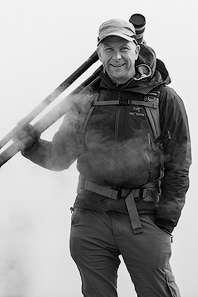
In his recent Photo Cascadia article Adrian Klein gives pointers on making the decision whether or not to upgrade cameras. New camera models are introduced every few months and they all tout various enhancements and features that are enticing to any photography enthusiast. However, unless you have an unlimited gear fund, it is important to remember that new features won’t make you a better photographer.
That said, when the time is right or the finances allow, it is always exciting to purchase a new rig. After using the heck out of my Canon EOS 5D Mark II for the last several years, I recently upgraded to the 5D Mark III. I thought I would share some of my first impressions of the camera for those who may be on the edge of making a purchase or for those who just like to geek out on camera reviews.
This review is a little different, however. Most camera reviews tend to get very technical and center around hair splitting, pixel by pixel analysis of test shots taken in staged situations. There are plenty of reviews on the web that have those bases covered. Despite small differences in image quality I think most can agree that the 5D Mark III takes great photos, as does the 5D Mark II, the new Nikon D800 and a truck load of other cameras. Instead of going there I’d like to share my favorite design features and improvements in the Mark III.
To their credit, while not as useful for creating marketing buzz or generating heated geek debate, Canon put some careful thought into small design details in the the 5D Mark III that add up to an enhanced user experience. Considering the hundreds or even thousands of hours I will spend in the cockpit of this camera, this is my list of favorite new features that I will silently appreciate even though they may not directly relate to image quality. The list is not exhaustive or in any particular order.
- Camera Mode Lock button – I really dislike it when I start photographing and find that while the camera was in my pack the camera mode dial was bumped from the mode I wanted to some other mode. The addition of a simple little button lock on the top of the camera mode wheel is going to save me a lot of frustration.
- Depth of field preview – This isn’t a new feature, but the new shape and placement of the button on the Mark III is a big deal for me. Instead of a very small button that was almost impossible to find under the lens on the left side of the camera, it is now a larger button located on the right side of the lens. It is within an easy, no-look reach of the grip hand. I might actually use it to visualize my depth of field now. It works quite well in Live View mode as well as through the viewfinder.
- In-camera leveling feature – I’m always losing or forgetting my flash mount bubble level. Now there is a level built right in the camera. Using iPhone like gyro technology (I’m guessing) the Mark III has a screen that tells you when the camera is level. The level is also accessible in Live View.
- Larger/higher resolution screen – Never a bad thing! Live view focusing is amazing.
- Easier access side covers – Inserting my cable release plug on the side of my Mark II required a key or screw driver and a lot of cursing to pry open the rubber door. Even with my fat fingers I can easily access the doors on the side of the Mark III. My blood pressure just went down 10 points.
- Better weather sealing – I rarely use rain covers or dust guards and I never had a problem with the Mark II, but I know people who have. The extra protection from moisture and dirt offers additional peace of mind.
- Quick Control Dial switch separate from power switch – A minor deal, but when these two were integrated I would sometimes turn on my camera and miss moving the switch far enough to activate the large scrolling wheel…and then spend several minutes scratching my head wondering why the wheel wasn’t working
- Deeper more ergonomic grip – Improving grip comfort and decreasing the chance I’ll drop my camera is a no-brainer.
- Up to 7 exposure auto bracketing – I always had exposure bracketing envy of Nikon users since they could auto bracket 9 exposures to Canon’s 3. The Mark III can bracket up to 7 exposures is a big improvement that covers the dynamic range of just about any scene.
- Multi-exposure composites – It is nice to be able to create in-camera exposure composites and overlaps just like back in the film days. This is a great way to get a properly exposed moon in a night landscape without the need to composite in Photoshop. Nikon has also had this feature for years.
If you have a new feature of the 5D Mark III you would like to share or comments on this or any other new camera you would like to make please feel free.

Sean is an outdoor photographer, digital image developing enthusiast and photography educator based in Ashland, Oregon, where he resides with his wife and two sons. His previous career as a science teacher makes photography education a good fit. Sean teams up with fellow Photo Cascadia members leading workshops. He also teaches digital image developing classes, lectures and offers a series of Photoshop video tutorials.
More posts by Sean Visit Sean’s Image Gallery Visit Sean’s Website

Recent Comments